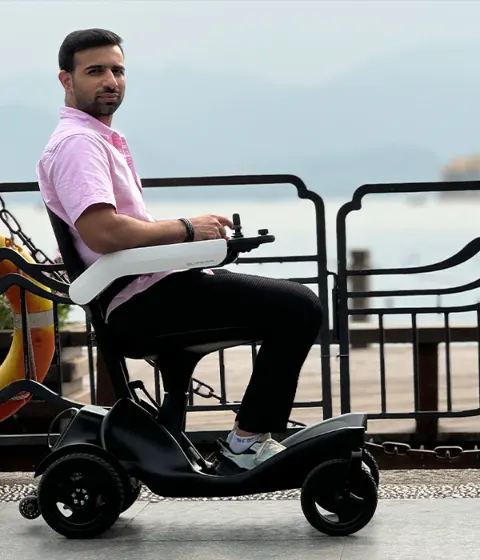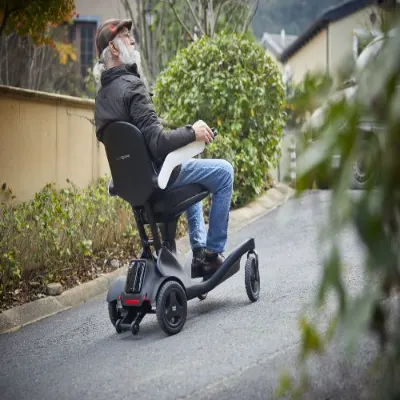
Speed in the real world is more than a top number. You move through elevators, curb cuts, and crowded atriums where smooth launches, short stops, and steady tracking matter most. A compact frame with dual brushless motors, calm start/stop logic, and reliable ramp holds keeps you quick at 3–4 km/h indoors and 5–6 km/h on sidewalks without drama. The rest—range, weight, splash protection—supports that flow, not the other way around.
What Counts as “Fast” in Real Daily Use?
Speed is more than a headline number. Indoors you move at a calm walking pace; outside you track with sidewalk flow. The useful bands look like this: 1–2 km/h for inching through crowds, 3–4 km/h for normal indoor travel, and 5–6 km/h on sidewalks with room to pass. Acceleration and braking shape confidence in each band. A chair that starts smoothly and stops cleanly often “feels” faster because you waste less time correcting lurches.
What Are the Practical Limits in Stores and Malls?
Store aisles change by season and display layout. You face blind corners, shiny tiles, and kids darting out of nowhere. Keep a “see–scan–slow” rhythm at intersections and elevator lobbies. A fast electric wheelchair only helps if the controller lets you dial a gentle ramp-up and crisp release-to-stop, so you hold position without rolling back on ramps.
Which Controller Settings Keep You Smooth?
Look for profiles that let you adjust acceleration and joystick sensitivity. Small dead-zone, soft initial launch, then steady cruise. Anti-rollback on slopes prevents that half-second drift that spooks riders and bystanders. A quiet controller plus brushless motors keeps torque predictable when you feather the stick.
How Do Indoor Spaces Change Safe Speed?
Indoor layouts punish impatience more than outdoor roads do. Elevators compress traffic, and polished stone or metal plates add slip risk. You win the day by flowing, not by blasting from point to point.
What Are the Practical Limits in Malls?
In big malls, crowd density and floor friction set your cap. If you want indoor speed settings that feel natural, aim for 3–4 km/h as a ceiling in busy zones, then drop closer to 2 km/h near food courts and queue lines. It sounds slow on paper but saves time because you keep moving without stop–start drama.
Which Small Habits Make You Faster Anyway?
Keep elbows in at doorways, roll center-left in wide corridors to avoid sudden merges, and pause a beat at intersecting aisles. These tiny habits remove emergency braking, which steals more minutes than a 0.5 km/h speed bump ever will.
How Should You Set Speed for Sidewalks and Crosswalks?
Sidewalk pace depends on surface, weather, and local foot traffic. On dry concrete with space to pass, 5–6 km/h feels natural. At crosswalks, speed matters less than positioning—point straight, keep hands ready, and avoid last-second turns.
What Is a Sensible Top Speed Outside?
If your routes include bus stops, school zones, or wet tiles outside store entrances, set an intermediate outdoor profile you can toggle to quickly. You’ll cut near-misses with little impact on travel time. For fast electric wheelchair for malls use, this quick toggle is handy when you bounce between plaza and atrium.
What Affects Stopping Distance?
Tire compound, pressure, and brake type do. Electromagnetic braking with a confident hold keeps stops short on smooth floors. Do a simple pre-ride brake check: roll at walking pace, release the stick, and confirm you halt within a single floor-tile length.
How Do Acceleration and Cornering Affect Stability?
Speed is harmless without stability. Indoors, too-quick launches feel like lunges; in turns, fast entries plus a tight radius can unload a caster.
What Acceleration Is “Too Quick” Indoors?
Watch for wheel spin, jolts that make you tap the brake, and frequent micro-brakes right after starting. If you see these, soften the launch curve and trim the joystick dead-zone so input matches intent.
How Fast Is Safe Through Turns?
Corner at walking speed in narrow hallways. Keep cargo low and centered. On threshold lips or metal plates, reduce speed a touch, then straighten before re-accelerating. Your shoulders will thank you after a full afternoon.
How Does Speed Change Range and Battery Life?
Higher speed increases rolling losses and bumps controller draw, so range drops. That’s fine if you plan for it. Battery choice is practical, not heroic.
What’s the Trade-Off Between Speed and Range?
If you cruise near 6 km/h outdoors for long stretches, expect the 10Ah pack to hit its range earlier. The 20Ah pack provides headroom for days with repeated ramps or headwinds. A 20 % buffer is a good rule—finish your loop with spare energy, not a blinking gauge.
When Do Dual Batteries or Swaps Make Sense?
Back-to-back errands, cold weather, or steep neighborhoods make quick swaps attractive. Removable packs let you reduce carry weight for trunk lifts and extend range on the fly.

Which Tires and Suspension Help at Higher Speeds?
Grip and filtering prevent fatigue. Solid tires remove flats; tread still matters on wet lobbies. Pressure that’s too hard chatters, too soft drags.
What Tire Choices Improve Grip on Smooth Floors?
Fine tread patterns help on polished stone. Test starts and stops near a safe wall; if you slip, drop speed and consider a different tread.
How Much Suspension Do You Need for City Use?
Independent rear suspension with rubber damping takes the slap out of lift plates and curb cuts. Over a week, fewer “stabilize” taps mean more relaxed shoulders and better control.
What Safety and Etiquette Rules Keep You Welcome?
Fast without fuss is the goal. People remember smooth riders, not necessarily the quickest ones.
What Are the “Fast but Calm” Habits Indoors?
Make eye contact at aisle crossings. Yield at elevators even when you arrive first. Park straight, and if a queue compresses, fold handles in. Little courtesies keep everyone moving.
What Visibility Aids Help in Crowds?
Low-glare lights and reflective accents help in mirrors and darker elevator cars. A polite horn beats a loud one; it signals without startling.
How Do You Tune Two Profiles You Can Trust?
Profiles give you consistency—one indoors, one outdoors. Switch when the environment changes and you’ll ride faster overall because you correct less.
What’s a Good Indoor Profile?
Top speed around 3–4 km/h, soft launch, higher brake assist, high traction control, and tight turning sensitivity. That’s how you stay quick in real terms, not just on paper.
What’s a Good Outdoor Profile?
Top speed near 5–6 km/h, moderate launch, stable cruise, and slightly lower steering sensitivity for straighter tracking on pavement. If you’re curious about how fast is an electric wheelchair indoors versus outside, these paired profiles make the difference obvious within a day.
What Checklist Confirms You’re “Fast Enough” Without Risk?
A short list beats best intentions. Do these five checks each week and you’ll keep pace without surprises.
The Five-Point Quick Check
Clean brake hold on a 10° ramp. No lurch on start/stop in a narrow aisle. One-hand pivot inside a typical elevator footprint. Stopping distance within a single aisle tile at indoor pace. Range margin of at least 20 % after your longest loop.
О Super Pi Robot
Super Pi Robot focuses on lightweight, travel-ready power chairs that move confidently in real buildings. The current platform blends a quick manual fold with a gas-assisted rigid lock for repeatable, low-effort folding. Dual 250 W brushless motors deliver calm launches and steady cruise, while removable 10Ah and 20Ah lithium packs give you clear choices for daily range. A compact standing fold—around 960 × 600 × 380 mm—fits typical apartment storage and rideshares, and IPX4 splash resistance handles wet sidewalks. Comfort is treated as a system: an integrated backrest with supportive cushioning, independent rear suspension with rubber damping, and tidy cable routing that avoids snags. The result is simple to explain—tight pivots in hallways, clean holds on ramps, and fewer mid-errand stops.
FAQ
Q1: What indoor speed keeps you quick without feeling risky?
A: Aim for 3–4 km/h with a soft launch curve and crisp release-to-stop. You’ll move faster overall because you avoid corrections and surprise stops.
Q2: How fast should you set the outdoor profile on sidewalks?
A: 5–6 km/h suits most sidewalks. Drop to an intermediate profile near bus stops, school zones, and wet tiles outside store entrances.
Q3: Do faster settings always cut travel time in malls?
A: Not necessarily. Smoother acceleration and clean stops save more time than a higher cap. Controller feel beats raw top speed indoors.
Q4: Which battery size makes sense for a long errand day?
A: Pick capacity to cover your route with a 20 % buffer. Use the lighter pack for short loops, the larger pack for back-to-back errands or repeated ramps.
Q5: What weekly check proves you’re set up well?
A: Confirm brake hold on a 10° ramp, verify one-hand pivots in an elevator footprint, and make sure you end your longest loop with at least 20 % charge.






